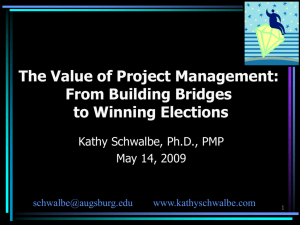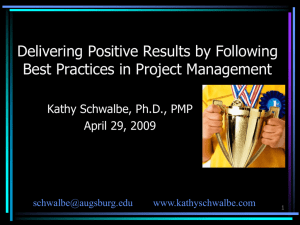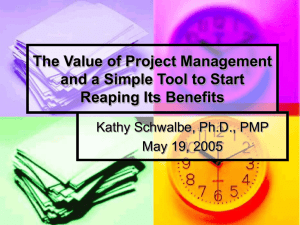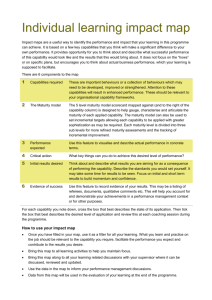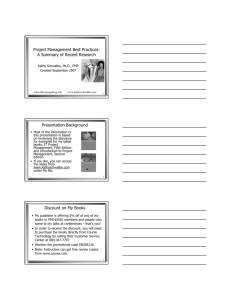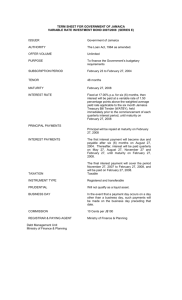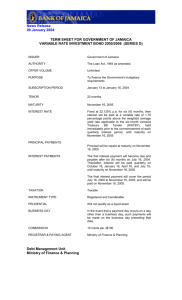The Value of Project Management
advertisement
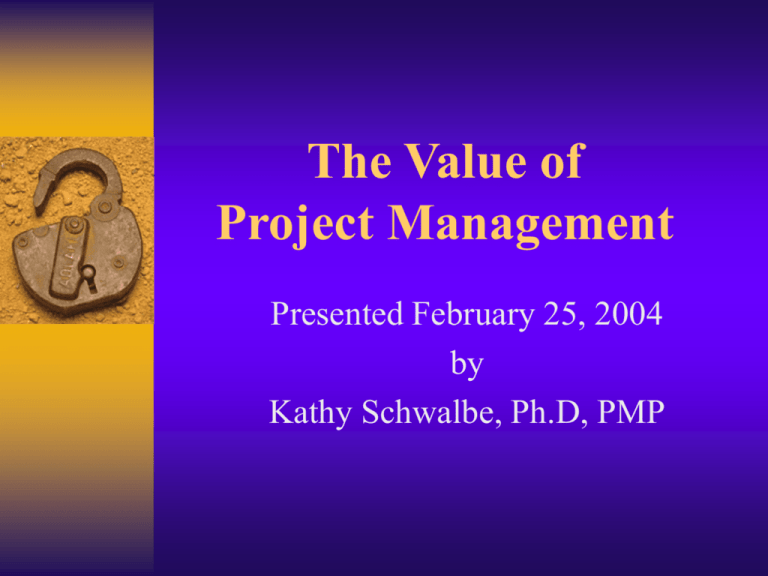
The Value of Project Management Presented February 25, 2004 by Kathy Schwalbe, Ph.D, PMP Presentation Outline Background information on project management Ways to measure the value of project management Examples of project management in health care organizations Question and answer session What is a Project? A project is “a temporary endeavor undertaken to accomplish a unique product or service” (PMBOK® Guide 2000, p. 4) Attributes of projects – – – – – unique purpose temporary require resources, often from various areas should have a primary sponsor and/or customer involve uncertainty Recent Project Statistics The U.S. spends $2.3 trillion on projects every year, an amount equal to one-quarter of the nation’s gross domestic product* More than sixteen million people regard project management as their profession; on average, a project manager earns more than $82,000 per year* IT Project Managers are still in great demand and earn over $95,000/year on average (Ziv, 2002) *PMI, The PMI Project Management Fact Book, Second Edition, 2001 What is Project Management? Project management is “the application of knowledge, skills, tools, and techniques to project activities in order to meet project requirements” (PMI*, Project Management Body of Knowledge (PMBOK® Guide), 2000, p. 6) In addition to meeting project requirements, it’s also important to satisfy key stakeholders and make sure the results of the project benefit the organization Project management should be a strategic as well as a tactical tool Project Management Framework* *Schwalbe, Kathy. Information Technology Project Management, Third Edition, 2004 Project Management Tools and Techniques Project management tools and techniques assist project managers and their teams in various aspects of project management Some specific ones include – Business cases, project charters, scope statements, and work breakdown structures (scope management) – Gantt charts, network diagrams, critical path analysis, critical chain scheduling (time management) – Cost estimates, project portfolio management, and earned value management (cost management) – See following charts for many more examples (all from Schwalbe text, 2004) Sample Gantt Chart Work Breakdown Structure (WBS) The WBS is on the left, and each task’s start and finish date are shown on the right using a calendar timescale. Early Gantt charts, first used in 1917, were drawn by hand. Sample Network Diagram Each box is a project task from the WBS. Arrows show dependencies between tasks. The bolded tasks are on the critical path. If any tasks on the critical path take longer than planned, the whole project will slip unless something is done. Network diagrams were first used in 1958. Sample Earned Value Chart Many PM experts recommend using earned value management to help track and manage projects. Assumes a good WBS, schedule, and cost information as well as entering actuals. Sample Enterprise PM Tool In recent years, organizations are taking advantage of software to help manage their projects throughout the enterprise. BUT… PMs Can’t Neglect Business and Leadership Skills • In addition to using appropriate PM tools and techniques, PMs must use – Business skills: financial analysis, problemsolving, decision-making – Leadership skills: negotiation, teambuilding – Communication skills: listening, speaking, writing, presenting Don’t Overemphasize Using PM Software • You can’t use PM software well if you don’t understand fundamental PM concepts • “A fool with a tool is still just a fool” Common PM Tools and Techniques by Knowledge Area Knowledge Area/Category Integration management Scope management Time management Cost management Tools and Techniques Stakeholder analysis Project plans Project management software Change control boards Configuration management Project review meetings Work authorization systems Project leadership Executive sponsorship Net present value, return on investment, payback Weighted scoring models Business cases Project charters Scope statements Work breakdown structures Statements of work Requirements analysis Scope change control Gantt charts Project network diagrams Critical path analysis Program evaluation review technique Critical chain scheduling Crashing Fast tracking Milestone reviews Earned value management Project portfolio management Cost estimates Cost management plan Financial software Common PM Tools and Techniques by Knowledge Area Knowledge Area/Category Quality management Human resource management Communications management Procurement management Risk management Tools and Techniques Six sigma Quality control charts Pareto diagrams Fishbone or Ishikawa diagrams Quality audits Maturity models Statistical methods Motivation techniques Empathic listening Team contracts Responsibility assignment matrices Resource histograms Resource loading Resource leveling Team building exercises Communications management plan Conflict management Communications media selection Communications infrastructure Status reports Meetings Virtual communications Templates Project Web sites Make-or-buy analysis Contracts Requests for Proposals or Quotes Source selection Negotiating E-procurement Risk management plan Probability/impact matrix Risk ranking Monte Carlo simulation Top-Ten Risk Item Tracking Hard Part About PM… “Because every project is unique, project managers and their teams must have a good understanding of what tools and techniques are available before they can make the more difficult decisions of which ones to use on their projects and how to implement them.” Schwalbe, Kathy, “Project Management Techniques”, The Internet Encyclopedia, Volume 3 (2004), p. 108 Ways to Measure Value Agreement on general benefits Improved project performance/results ROI of project management PM maturity levels Competitive advantage “Price is what you pay. Value is what you get.” Warren Buffet General Benefits of Project Management Better control of financial, physical, and human resources Improved customer relations Shorter development times Lower costs Higher quality and increased reliability Improved productivity Better internal coordination Higher worker morale (less stress) Improved Project Performance Project success is often based on meeting project scope, time, and cost goals The Standish Group’s CHAOS studies are well known for documenting IT project success rates and cost of failures* Measure Successful projects Failed projects Money wasted on challenged and failed projects 1994 Data 16% 31% $140 B out of $250 B *PM Network, July 2003, p. 16 2002 Data 34% 15% $55 B out of $255 B Result Doubled Halved More than halved Why the Improvements? "The reasons for the increase in successful projects vary. First, the average cost of a project has been more than cut in half. Better tools have been created to monitor and control progress and better skilled project managers with better management processes are being used. The fact that there are processes is significant in itself.“* *The Standish Group, "CHAOS 2001: A Recipe for Success" (2001) Improvements to Key IT Project Metrics Due to Project Management* Sc he St Cu du le ra s te tom es gi er tim c a bu s sin atis ting f C os ess act t/h al ion or ign s es me T nt S c im ti he e a ma du nd ting le bu p dg e La r f et or bo m rh an ou ce rs Q C per ual os fo it t p rm y er an f R orm ce es a St pon nce af f p se t ro im Ti du e m ct e i to vity m ar ke t % Improvement 45 38.6 37.6 37 40 32.8 32.5 32.1 31.9 35 30 25.6 23.8 23 22.8 21.7 25 20 15 10 5 0 *Value of Project Management in IT Organizations survey,Center for Business Practices, 2002, cited in PM Network, July 2003, p. 16 “What the Winners Do”* • Recent research findings show that companies that excel in project delivery capability: – Build an integrated project management toolbox (use standard/advanced PM tools, lots of templates) – Grow competent project leaders, emphasizing business and soft skills – Develop streamlined, consistent project delivery processes – Install a sound but comprehensive set of project performance metrics *Milosevic, Dragan, Portland State University, “Delivering Projects: What the Winners Do,” PMI Conference Proceedings, November 2001 Using a Standardized Project Management Approach* Research found that a consistent (one-size- fits-all) managerial approach may be essential to the successful standardization of certain aspects of project management, and a contingency approach is needed for certain aspects, too Low standardization with a sufficient amount of variation is the more appropriate approach *Milosevic and Pantanakul, “The Impact of Standardized Project Management: New Product Development Projects versus Software Development Projects,” Proceedings of PMI Research Conference 2002 Findings From 5-Year Study on Quantifying the Value of PM* 1. 2. 3. Companies with more mature project management practices have better project performance (on time and budget vs. 40% over time and 20% over cost targets) Project management maturity is strongly correlated with more predictable project schedule and cost performance (i.e. .08 schedule performance index variation vs. .16) Good project management companies have lower direct costs than poor project management companies (6-7% vs. 11-20%) *Ibbs, William and Justin Reginato, Quantifying the Value of Project Management (2002) Project Management ROI* Over 94% of senior project management professionals say that implementing PM added value to their organizations Formula to predict increased company ROI based on increased PMM level – Determine cost to improve PMM level, improvement in cost performance index (CPI), then calculate PM ROI using profit margins and projected annual revenues *Ibbs, William, “The $$$ Value of Project Management: Continuing the Search for PM’s ROI,” PDS ’02 Conference Proceedings, PMI-ISSIG http://www.ce.berkeley.edu/pmroi/PMROI%20PMI%20Presentation%20Feb2001.pdf PM ROI Example* Company initially has PMM of 2.3, CPI of .71, profit margin of 5% , $10 M projected annual revenues Company improves PMM to 3.1, CPI to .94, profit margin to 6.6% at a cost of $400,000 PM ROI = (6.6%-5.0%)X$10,000,000 = 40% $400,000 *Ibbs, William, “Managing Chaotic Projects: Improving your PM/ROI” http://www.ce.berkeley.edu/pmroi/PMROI%20PMI%20Presentation%20Feb2001.pdf Project Management Maturity Models Similar to maturity models for improving software like the Capability Maturity Model (CMM) Several PM firms have their own maturity models, most using levels 1-5 – The International Institute for Learning, Inc. calls the five levels common language, common processes, singular methodology, benchmarking, and continuous improvement – ESI’s five levels are called ad hoc, consistent, integrated, comprehensive, and optimizing – PMI’s Organizational Project Management Maturity Model (OPM3) released their model in 2004 Berkeley Project Management Process Maturity Model Sample PMM Assessment Questions* Project Management Maturity by Knowledge Area and Industry Feedback from Bill Ibbs* We've benchmarked a couple healthcare organizations…what I can say is that the IT PM capability of those organizations was poor, especially in terms of initiating projects. We helped one of those companies save several million dollars over a 2 year period by helping them focus better on the projects they launched.” Wall Street reports that the healthcare industry in general is gearing up to spend even more $$$ on IT in the next couple years than they have in the past. So there's a lot at stake.” * From e-mail correspondence Feb. 2, 2004 Other Research Suggests That PM Maturity Models Only Measure Explicit Knowledge* Explicit knowledge: “know what,” can be put into IT, a digital or discrete process that can be codified and transmitted in formal, systematic language (Nonaka 1994) Tacit knowledge: “know how”, in one’s experience; hard to replicate and can be transferred indirectly though time consuming socialization processes (Kaplan et al 2001) *Jugdev and Thomas, “Blueprint for Value Creation: Developing and Sustaining a Project Management Competitive Advantage Through the Resource Based View,” Proceedings of PMI Research Conference, 2002 Need to Make PM a Strategic Asset (Just Like IT) Many executives view project management as having worth at the operational and tactical rather than strategic level Resource Based View (RBV) frameworks emphasize how firms create value and profits from their internal resources and focus on strategic assets RBV is relevant to project management because it emphasizes intellectual capital Research Based View Model* high Social Capital Strategic Assets Know How PM Maturity low Know What low high Need to combine know what with know how to make PM a strategic asset! *Jugdev, Kam, presented at PMI Research Conference, July 2002 Successful Examples of Applying PM in Healthcare Organizations Theory of Constraints aids in scheduling Focusing on meeting goals with good PM helps organizations meet demands under budget constraints Good project managers are critical to successful drug launches Applying the Theory of Constraints (TOC) in Health Care* TOC is a form of systems thinking that suggests that any complex system at any point in time often has only one aspect or constraint that limits its ability to achieve more of its goal. Need to exploit constraint and adjust scheduling and resource usage – A USAF base decreased waiting time for primary care appointments from 17 days to 4.5 at no additional cost – Radcliff Infirmary in Oxford, England used TOC to improve waiting times for neurosurgery and ophthalmology (noted a 100% reduction in elective cancellations and increases in throughput of over 16% at no additional cost *Breen, Anne, Tracey Burton-Houle, and David C. Aron, “Applying the Theory of Constraints in HealthCare: Part 1 – The Philosophy,” Quality Management in Health Care, (Vol 10, Number 3), Spring 2002, www.goldratt.com/for-cause/applyingtocinhcpt1fco.htm Meeting Goals With Good Project Management* St. Mary’s National Health Service (NHS) in London was facing a huge deficit, problems in staffing, and long outpatient waiting times They focused on meeting specific goals by getting the right resources in the right places at the right times (basic PM concepts) and went from a one star to a three star rating by their trust * Williams, Monica, “Healthy Returns,” PM Network, February 2002 Pharmaceutical Project Managers Are a Breed Apart* Significant investments in drug development projects (12 years and $800M on average), the magnitude of risks in the development cycle, and extensive involvement of senor management makes it especially tough being a PM in this industry “I know of no pharmaceutical company today attempting drug development without a project manager to oversee it” (Luis Cabassa, PMP, Genetech Inc.) Pappas, Lorna, “The Right Prescription,” PM Network, October 2002 Examples of How Good Project Management Adds Value at Your Organization? Question & Answer Session Feel free to contact me at schwalbe@augsburg.edu Visit my Web site at www.kathyschwalbe.com
